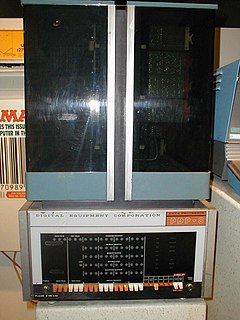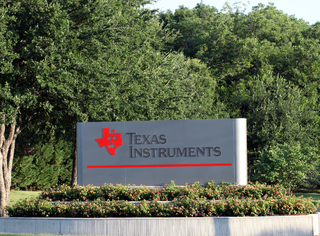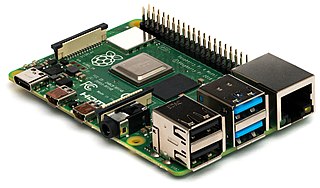Related Research Articles

A minicomputer, or colloquially mini, is a class of smaller computers that was developed in the mid-1960s and sold for much less than mainframe and mid-size computers from IBM and its direct competitors. In a 1970 survey, The New York Times suggested a consensus definition of a minicomputer as a machine costing less than US$25,000, with an input-output device such as a teleprinter and at least four thousand words of memory, that is capable of running programs in a higher level language, such as Fortran or BASIC.

Texas Instruments Incorporated (TI) is an American technology company headquartered in Dallas, Texas, that designs and manufactures semiconductors and various integrated circuits, which it sells to electronics designers and manufacturers globally. It is one of the top 10 semiconductor companies worldwide based on sales volume. The company's focus is on developing analog chips and embedded processors, which account for more than 80% of its revenue. TI also produces TI digital light processing technology and education technology products including calculators, microcontrollers and multi-core processors. The company holds 45,000 patents worldwide as of 2016.

A microcomputer is a small, relatively inexpensive computer with a microprocessor as its central processing unit (CPU). It includes a microprocessor, memory and minimal input/output (I/O) circuitry mounted on a single printed circuit board (PCB). Microcomputers became popular in the 1970s and 1980s with the advent of increasingly powerful microprocessors. The predecessors to these computers, mainframes and minicomputers, were comparatively much larger and more expensive. Many microcomputers are also personal computers.

The IBM Series/1 is a 16-bit minicomputer, introduced in 1976, that in many respects competed with other minicomputers of the time, such as the PDP-11 from Digital Equipment Corporation and similar offerings from Data General and HP. The Series/1 was typically used to control and operate external electro-mechanical components while also allowing for primitive data storage and handling.

Wang Laboratories was a computer company founded in 1951, by An Wang and G. Y. Chu. The company was successively headquartered in Cambridge, Massachusetts (1954–1963), Tewksbury, Massachusetts (1963–1976), and finally in Lowell, Massachusetts (1976–1997). At its peak in the 1980s, Wang Laboratories had annual revenues of $3 billion and employed over 33,000 people. It was one of the leading companies during the time of the Massachusetts Miracle.

A superminicomputer, colloquially supermini, was a high-end minicomputer. The term was used to distinguish the emerging 32-bit architecture midrange computers introduced in the mid to late 1970s from the classical 16-bit systems that preceded them. The development of these computers was driven by the need of applications to address larger memory. The term midicomputer had been used earlier to refer to these systems. Virtual memory was often an additional criteria that was considered for inclusion in this class of system. The computational speed of these machines was significantly greater than the 16-bit mincomputers and approached the performance of small mainframe computers. The name has at times been described as a "frivolous" term created by "marketeers" that lacks a specific definition. Describing a class of system has historically been seen as problematic: "In the computer kingdom, taxonomic classification of equipment is more of a black art than a science." There is some diagreement about which systems should be included in this class. The origin of the name is uncertain.
The Data General RDOS was a real-time operating system released in 1970. The software was only sold bundled with the company's popular Nova and Eclipse minicomputers.
TRW Inc., was an American corporation involved in a variety of businesses, mainly aerospace, automotive, and credit reporting. It was a pioneer in multiple fields including electronic components, integrated circuits, computers, software and systems engineering. TRW built many spacecraft, including Pioneer 1, Pioneer 10, and several space-based observatories. It was #57 on the 1986 Fortune 500 list, and had 122,258 employees. The company was called Thompson Ramo Wooldridge Inc., after the 1958 merger of the Ramo-Wooldridge Corporation and Thompson Products. This was later shortened to TRW.
Abbott Laboratories is an American multinational medical devices and health care company with headquarters in Abbott Park, Illinois, United States. The company was founded by Chicago physician Wallace Calvin Abbott in 1888 to formulate known drugs; today, it sells medical devices, diagnostics, branded generic medicines and nutritional products. It split off its research-based pharmaceuticals business into AbbVie in 2013.

Analog Devices, Inc. (ADI), also known simply as Analog, is an American multinational semiconductor company specializing in data conversion, signal processing and power management technology, headquartered in Norwood, Massachusetts. In 2012, Analog Devices led the worldwide data converter market with a 48.5% share, according to analyst firm Databeans.
Prime Computer, Inc. was a Natick, Massachusetts-based producer of minicomputers from 1972 until 1992. With the advent of PCs and the decline of the minicomputer industry, Prime was forced out of the market in the early 1990s, and by the end of 2010 the trademarks for both PRIME and PRIMOS no longer existed

Adaptec was a computer storage company and remains a brand for computer storage products. The company was an independent firm from 1981 to 2010, at which point it was acquired by PMC-Sierra, which itself was later acquired by Microsemi, which itself was later acquired by Microchip Technology.
Pertec Computer Corporation (PCC), formerly Peripheral Equipment Corporation (PEC), was a computer company based in Chatsworth, California which originally designed and manufactured peripherals such as floppy drives, tape drives, instrumentation control and other hardware for computers.

The ADM-3A was an influential early video display terminal, introduced in 1976. It was manufactured by Lear Siegler and had a 12-inch screen displaying 12 or 24 lines of 80 characters. It set a new industry low single unit price of $995. Its "dumb terminal" nickname came from some of the original trade publication advertisements. It quickly became commercially successful because of the rapid increase of computer communications speeds, and because of new minicomputer systems released to the market which required inexpensive operator consoles.
Systems Engineering Laboratories was a manufacturer of minicomputers in Fort Lauderdale, Florida. It was one of the first 32-bit realtime computer system manufacturers. Realtime computers are used for process control and monitoring.

The Wang 2200 appeared in May 1973, and was Wang Laboratories' first minicomputer that could perform data processing in a common computer language. Unlike some other desktop computers, such as the HP 9830, it had a cathode-ray tube (CRT) in a cabinet that also included an integrated computer-controlled cassette tape storage unit and keyboard. Microcoded to run interpretive BASIC, about 65,000 systems were shipped in its lifetime and it found wide use in small and medium-size businesses worldwide.

The Honeywell 316 was a popular 16-bit minicomputer built by Honeywell starting in 1969. It is part of the Series 16, which includes the Models 116, 316 (1969), 416 (1966), 516 (1966) and DDP-716 (1969). They were commonly used for data acquisition and control, remote message concentration, clinical laboratory systems, Remote Job Entry and time-sharing. The Series-16 computers are all based on the DDP-116 designed by Gardner Hendrie at Computer Control Company, Inc. (3C) in 1964.
Interdata, Inc., was a computer company, founded in 1966 by a former Electronic Associates engineer, Daniel Sinnott, and was based in Oceanport, New Jersey. The company produced a line of 16- and 32-bit minicomputers that were loosely based on the IBM 360 architecture but at a cheaper price. In 1974, it produced one of the first 32-bit minicomputers, the Interdata 7/32. The company then used the parallel processing approach, where multiple tasks were performed at the same time, making real-time computing a reality.
Systime Computers Ltd was a British computer manufacturer and systems integrator of the 1970s and 1980s. During the late 1970s and early 1980s, Systime become the second largest British manufacturer of computers, specializing in the minicomputer market.
References
- ↑ "Acquisitions". Computerworld. May 23, 1973. p. 34. Retrieved September 26, 2016.
- ↑ Toni Wiseman (February 2, 1976). "Bunker-Ramo Decides To Ax POS Operation". Computerworld. p. 1. Retrieved September 26, 2016.
- ↑ "Nuclear Data Inc., which makes and sells printed circuit..." Chicago Tribune. Chicago, IL. July 5, 1989. Retrieved September 26, 2016.
| This United States manufacturing company–related article is a stub. You can help Wikipedia by expanding it. |